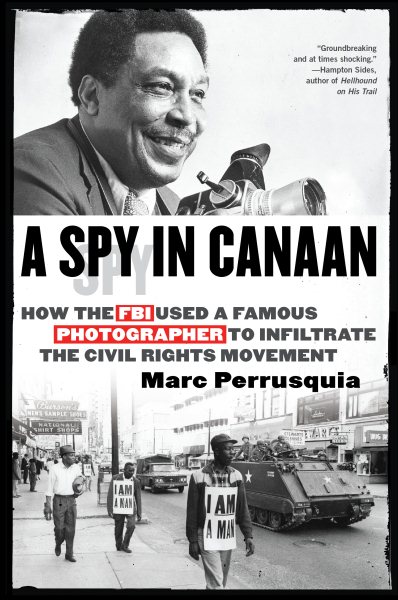By Jim Ewing. Special to the Clarion-Ledger Sunday print edition (August 26)
If you know of someone who still harbors any doubt that the FBI spied on leaders of the civil rights movement, just hand over a copy of investigative reporter Marc Perrusquia’s book A Spy in Canaan.
 As a reporter for The Commercial Appeal, Perrusquia caught wind of a tantalizing story: that one of Memphis’ most well-known and respected Beale Street residents who had rubbed shoulders with the highest leaders of the movement was for nearly 20 years an FBI informant.
As a reporter for The Commercial Appeal, Perrusquia caught wind of a tantalizing story: that one of Memphis’ most well-known and respected Beale Street residents who had rubbed shoulders with the highest leaders of the movement was for nearly 20 years an FBI informant.
In Spy, subtitled “How The FBI Used a Famous Photographer to Infiltrate the Civil Rights Movement,” Perrusquia offers exhaustive research, including the FBI’s own secret informant files, to detail the government’s surveillance.
As Perrusquia chronicles, to most Beale Street residents, Ernest Withers was the local photographer who took photos of wedding engagements, family portraits, school and military achievements.
To leaders of the civil rights movement, Withers was equally embedded. Carrying press credentials for prominent black-oriented newspapers and magazines, he was a fixture who was there in the very beginning.
He sneaked a photo in the courtroom during the trial of Emmett Till. He covered integration riots in Little Rock and Ole Miss. He covered the assassination of Medgar Evers, whom he considered a friend. He was such a fixture that he counted among his photos candid scenes of Dr. Martin Luther King Jr.—and was so well regarded, he was allowed into the autopsy room to take death photos after King’s assassination.
Although little heralded in his life, Withers could arguably be called one of the great photographers of the 20th century, Perrusquia reports. He shot as many as one million photos over 60 years documenting black life in the South.
Yet, as Perrusquia conclusively details, Withers also led a double life, working for the FBI for cash, funneling photos of civil rights leaders and suspected “agitators” from 1958 to 1976. He passed on tips, car tag numbers, juicy gossip, funneling a flood of rumors, facts and falsehoods that could (and did) ruin people’s lives.
Perrusquia chronicles Withers’ activities in painstaking, deep detail, revealing a disturbing portrait of a quintessential mole in the movement.
Spy is a monumental work of investigative journalism, drawing not only from his newspaper reporting, but also with fresh facts that add a troubling perspective to the headlines of today, raising questions about the depth, longevity and resilience of the government’s focus on watching its citizens.
Not only does Perrusquia describe the FBI surveillance of the period, but examines the federal and local police programs in place that operated beyond the law, including:
- COINTELPRO — A federal domestic spying program that surveilled citizens and often employed dirty tricks and misinformation to discredit citizens the FBI deemed suspect.
- DETCOM — The nation’s secret program to identify and round up dissidents or people identified with suspected organizations in the event of an emergency.
It’s frightening that even with the enormous amount of data the FBI obtained just from Withers and those working with him at the time, that’s only a slice of the surveillance of U.S. citizens then and, most certainly with digital methods, now.
Jim Ewing, a former writer and editor at the Clarion Ledger, is the author of seven books including his latest, Redefining Manhood: A Guide for Men and Those Who Love Them.
Marc Perrusquia will appear at the Mississippi Book Festival August 17 as a participant in the “Photography and Culture” panel at 2:45 p.m. at the Galloway Foundery.


Comments are closed.